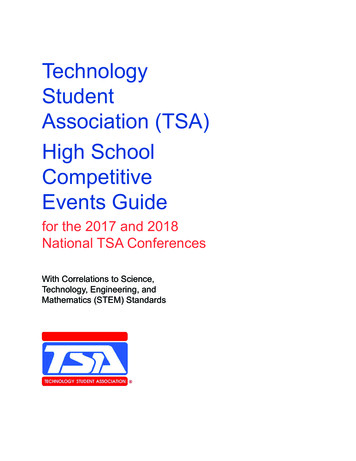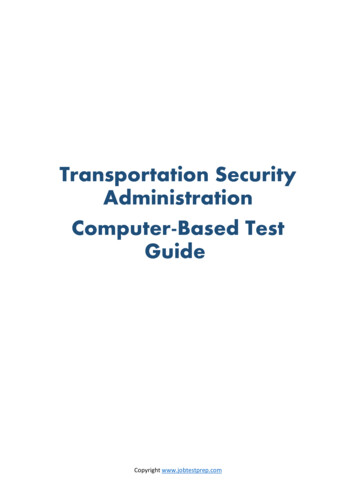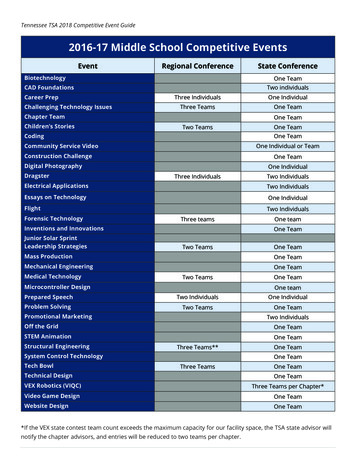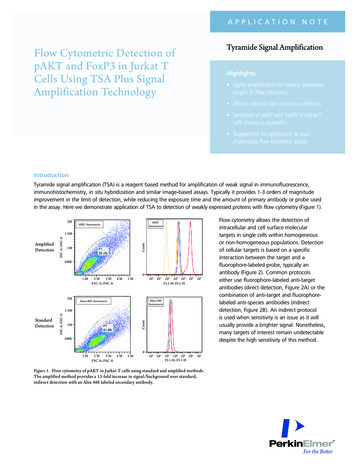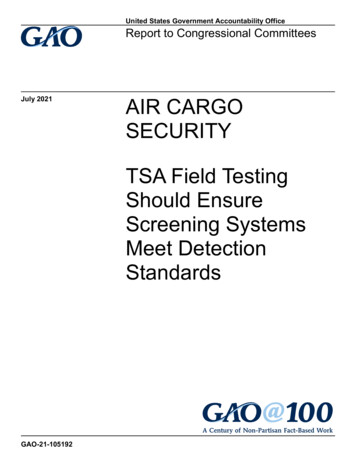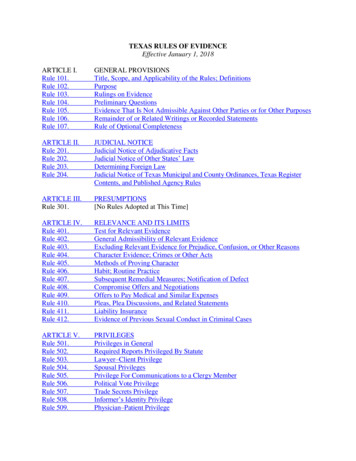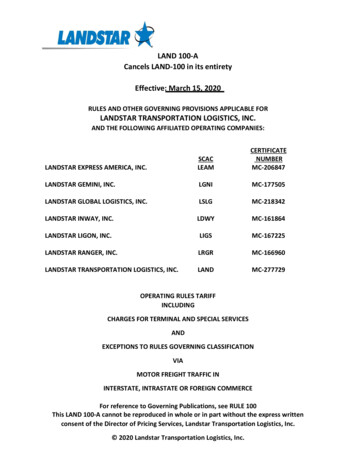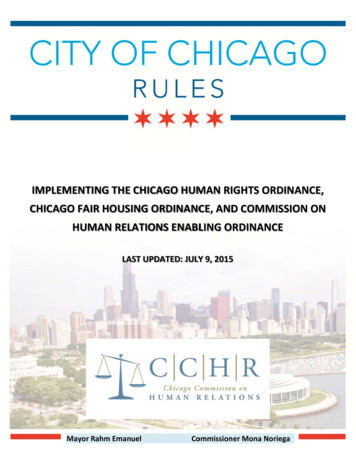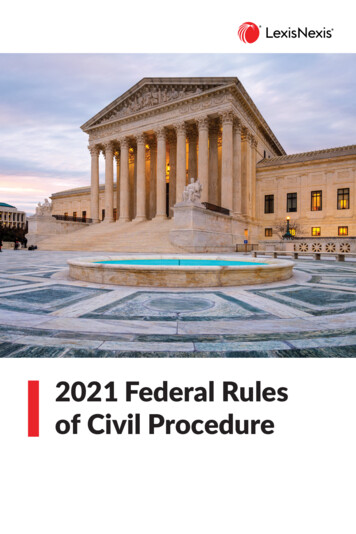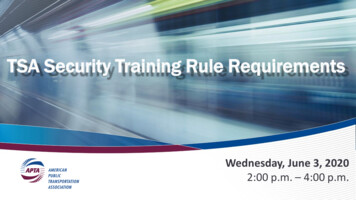
Transcription
TSA Security Training Rule RequirementsWednesday, June 3, 20202:00 p.m. – 4:00 p.m.
Welcome and IntroductionsEmani Lee-OdaiProgram Manager – Safety & SecurityTechnical Services and InnovationAmerican Public Transportation Association
Opening RemarksChristopher T. McKayMass Transit Industry Engagement ManagerIndustry Engagement BranchPolicy, Plans, and EngagementTransportation Security AdministrationArlington, VAMr. Ronald Pavlik, Jr.Chief of PoliceWashington Metropolitan Area TransitAuthority (WMATA)Washington, DC
PresenterHarry SchultzSection Chief, Policy Evaluation SectionDivision: Surface Policy DivisionOffice: Policy, Plans, and EngagementTransportation Security Administration
Housekeeping This webinar will be recorded andmade available on APTA’s website All attendee phone lines are muted To ask a question, use the QuestionsPanel; questions will be answered atthe end of the presentations
PanelistsScott GordonExecutive Director, Surface DivisionPolicy, Plans, and EngagementTransportation SecurityAdministrationArlington, VAVictor ParkerTransportation Security SpecialistSurface DivisionPolicy, Plans, and EngagementTransportation SecurityAdministrationArlington, VADavid H. KasminoffSenior Counsel for Regulations &Security StandardsDepartment of Homeland SecurityTransportation SecurityAdministrationArlington, VA
Security Trainingfor SurfaceTransportationEmployeesFinal RuleA Presentation for PublicTransportation Agencies andPassenger RailroadsJune 3, 20207
Security Training Rule SummaryOn March 23, 2020, TSA published the Security Training forSurface Transportation Employees Final Rule in theFederal Register.In special consideration of on-goingchallenges to the surface transportationindustry in response to the NovelCoronavirus (COVID-19), TSAamended this rule on May 1, 2020,extending the rule’s effective date fromJune 22, 2020 to September 21, 2020.8
Security Training Rule SummaryThe rule requires owner/operators of higher-risk freightrailroad carriers, public transportation agencies(including rail mass transit and bus systems),passenger railroad carriers, and over-the-road buscompanies to provide TSA-approved security trainingto employees who perform security-sensitivefunctions.TSA is also expanding its requirements for securitycoordinators and the reporting of significant securityconcerns (currently limited to rail operations) toinclude certain bus operations within the scope of theregulation.9
Organization of the Rule 49 CFR Part 1500 has been restructured into generaland mode-specific partsParts 1570 and 1582 contains key requirements thatimpact the public transportation/passenger rail modePARTPARTPARTPARTPARTPARTPART1500 –Terms and Abbreviations1503 – Investigative and Enforcement Procedures1520 – Protection of Sensitive Security Information1570 – General Rules (applicable to all modes)1580 – Freight Rail Security1582 – Public Transportation and Passenger Railroad Security1584 – Highway and Motor Carriers10
Which Public Transportation and Passenger Rail Operators AreCovered by the Rule? Higher-risk public transportation (rail andbus) and passenger rail operations arecovered.– Amtrak– The 46 specific agencies and companieslisted in Appendix A to Part 1582– Owner/operators that serve as a host railroadto a freight operation described in §1580.30111
What Are the Key Requirements of this Rule?Each owner/operator covered by this rulemust: Designate a Security Coordinator and at leastone alternate Security Coordinator Report significant security concerns to TSA Develop a comprehensive security trainingprogram Provide security training to employees insecurity-sensitive positionsDesignating security coordinators and reportingsignificant security concerns to TSA are newrequirements for transit bus operations in higher-risklocations12
What Are the Significant Dates In This Rule? The Security Training Rule becomes effective September 21, 2020 Owner/operators must notify TSA of their applicabilitydetermination by October 21, 2020 Owner/operators must report to TSA the names and contactinformation of a security coordinator and an alternate securitycoordinator by October 28, 2020 Owner/operators must submit their training programs to TSA forapproval by December 21, 2020 Owner/operators must ensure employees in security sensitivepositions complete initial training within one (1) year after TSAapproves the training program Employees in sensitive-security positions must receive refreshertraining at least once every three years13
How Do I Notify TSA That The Rule Applies to MyAgency/Company?Send an email to: SecurityTrainingPolicy@tsa.dhs.gov. Include in the subject line of the email: Security TrainingRule Applicability (Agency or Company name) Include in the body of the email: Mode of Transportation (e.g. public transportation orpassenger rail) Owner/operator corporate name Optional: Doing business as (DBA) name Corporate address Contact name, email address, and phone numberSee § 1570.10514
Security Coordinators (1570.201)What is a Security Coordinator? Security Coordinators are security liaisons to TSA, providing asingle point of contact for receiving communications and inquiriesfrom TSA concerning threat information or security procedures.Security Coordinators must be appointed at the corporate level.What is required of a Security Coordinator? Serves as the primary contact for intelligence information andsecurity-related activities and communications with TSA. Anyindividual designated as a Security Coordinator or alternate SecurityCoordinator may also perform other corporate duties as required. Is accessible to TSA on a 24 hours a day, 7 days a week basis. Coordinates security practices and procedures internally and withappropriate law enforcement and emergency response agencies.15
How Do I Submit Security CoordinatorInformation to TSA?Via email: Send email to: TSA.seccord@tsa.dhs.govInclude in the subject line of your email: Security CoordinatorContact Info - (Agency or Company Name). Include thefollowing information in the body of the email for the SecurityCoordinator and the alternate Security Coordinator: First and last name Title Office and mobile telephone numbers Email address U.S. citizenship status Corporate address (optional) Shipping/mailing address (optional)16
How Do I Determine Which Employees Fall Within a SecuritySensitive Category?Owner/operators may determine if an employee falls within in asecurity-sensitive category and function by referring to Appendix Bto Part 49 CFR 1582, Security-Sensitive Job Functions ForPublic Transportation and Passenger Railroads. Categoriesinclude employees/contractors performing the following functions: Operating a vehicle Inspecting and maintaining vehicles Inspecting or maintaining building or transportation infrastructure Controlling dispatch or movement of a vehicle Providing security of equipment and property Loading or unloading cargo or baggage Interfacing with traveling public Complying with security programs or measuresPer Section 1570.3, employee means an individual who is engaged or compensated by anowner/operator regulated under this subchapter, or by a contractor to an owner/operatorregulated under this subchapter. The term includes direct employees, contractoremployees, authorized representatives, immediate supervisors, and individuals who areself-employed.17
Reporting Significant Security ConcernsRequirements for reporting: Each owner/operator identified in §1582.1 must report, within24 hours of initial discovery, any potential threats andsignificant security concerns involving transportation-relatedoperations in the United States or transportation to, from, orwithin the United States as soon as possible using themethods prescribed by TSA. Potential threats or significant security concerns encompassincidents, suspicious activities, and threat informationincluding, but not limited to, the categories of reportableevents listed in Appendix A to Part 1570. Reports are to be made telephonically to the TSATransportation Security Operations Center (TSOC) by calling1-866-615-5150See §1570.20318
Required Elements of Security TrainingTraining must address:PREPAREOBSERVEASSESSRESPOND Employee (craft) specific responsibilities Duties as applicable in the security plan Awareness and recognition ofsuspicious persons and items Determine if an item or situationrequires a response Know how to report and react tosecurity threatsSee §1582.11519
What Information Must a Training ProgramContain?1. Administrative Information Name of owner/operator Name and contact information of security training program POC Number, by specific job function category, of security-sensitiveemployees trained or to be trained Implementation Schedule Location where training program records will be maintained Curriculum or lesson plan learning objectives, and method ofdelivery Plan for ensuring supervision of untrained security-sensitiveemployees. Plan of notifying employees of changes to security measuresMethod(s) for evaluating the effectiveness of the securitytraining programSee §1582.11320
Can an employer use existing training to meetthe requirements of this rule?Yes, an employer can use applicable training that hasbeen prepared or delivered for other purposes. Ifexisting training will be used, then the trainingprogram must include: An index organized in the same sequence asthe requirements of the rule. This index should clearly show the alignment ofpre-existing or previous training to the requiredelements of this rule.See §1582.113(c)(1)&(2)21
How Do I Provide a Copy of My Training Programto TSA?TSA will provide details for submission of trainingprograms after receiving confirmation from theowner/operator that they are subject to the rule perapplicability determination requirements covered in§1570.105 of the rule.TSA intends to send this information to theowner/operator’s Security Coordinator.22
Is TSA providing model training or training aidsfor this rule?TSA has produced three videos intended to help you satisfypart of the Observe, Assess, and Respond security trainingelements required by the rule. Videos for these sub-modes oftransportation will be available: Mass Transit Bus Mass Transit Rail Passenger RailTo request one or more of the videos, send your request viaemail to: SecurityTrainingPolicy@tsa.dhs.gov. Include in the subject line of the email: Security TrainingVideos for (Agency or Company) Include in the body of the email the which video(s) areneeded and a mailing address for delivery23
Recommended Next StepsObtain a copy of the Security Training Rule FactsheetThe Factsheet Contains:- A Regulatory Overview- General Applicability- Significant Timeline- Regulatory Timeline- Web Link to Security Training Rule- TSA Contact Email AddressRead the Security Training Rule- Preamble – For the spirit and intent of the rule- Regulatory Text – For the rule’s requirements24
For questions or additional informationContact the TSA Surface Policy Team By email SecurityTrainingPolicy@tsa.dhs.gov By voicemail – (571) 227-556325
Questions?Thank you for your participation!For further informationwww.tsa.gov/for-industry26
Closing RemarksScott GordonExecutive Director, Surface DivisionPolicy, Plans, and EngagementTransportation Security AdministrationArlington, VAPolly HansonSenior Director Security, Risk andEmergency ManagementAmerican Public Transportation AssociationWashington, DC
AdjournmentThank you for your participation!For additional information visit: www.apta.comView the recording of today’s webinar and download the presentation materials starting onFriday, June 5, 2020I28
Security Training Rule Summary. On March 23, 2020, TSA published the Security Training for Surface Transportation Employees Final Rule in the . Federal Register. 8. In special consideration of on-going challenges to the surface transportation industry in response to the Novel Coronavirus (COVID -19), TSA amended this rule on May 1, 2020,
